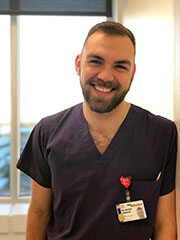Canadian Intensive Care Week: This way out!
Early mobilization increases the chances of ICU patients to be discharged more quickly
Marc-Antoine Ladouceur has been working as a nurse in the Royal Victoria Hospital intensive care unit of the McGill University Health Center (MUHC) since 2015, and like all his colleagues, he wants patients to spend as little time as possible on the floor. "Our goal here is to do everything possible to make their stay a short one, not because we don't like our patients, it's quite the opposite! It’s just that the longer they stay on the unit, the more likely they are to have various complications," says Marc-Antoine with conviction.

One of the most successful approaches used to achieve this for patients of the intensive care units is early rehabilitation. At one time, it was out of the question to move patients during a period of acute care, but today this is not the case anymore, as prolonged immobilization and extensive sedation can lead to muscle and neurological impairments.
One way to reduce these negative effects is to get the patient moving as soon as they are stable, and it is safe to do so. Physiotherapists are the most sought-after professionals for complex cases that require extensive expertise, but for simple interventions, nurses and physiotherapists can work collaboratively.
Passive mobilization
Passive mobilization can be as simple as a move from a bed to a chair, but still requires the participation of at least four to five people to ensure safety: a nurse, beneficiary attendant, respiratory therapist, perfusionist and physiotherapist.
"The patient often finds themselves in a situation where they have continuous mechanical ventilation or dialysis treatments. We need to check all the tubes and see which ones can be temporarily disconnected to minimize the risk of accidental withdrawal,” explains Marc-Antoine. “Then, a lever with a canvas, installed on the ceiling of each room, takes the patient and lifts them slowly onto an armchair. The patient will be able to stay there for an hour or two, ideally twice a day. All this maneuvering can take up to forty-five minutes to perform for some patients. But it's worth it because the longer patients stay still, the more likely they are to develop all kinds of complications," continues the nurse.
For Sylvie Ampleman, nurse manager in the Intensive Care Unit, the benefits of passive mobilization are evident and the contraindications almost non-existent: "The action of lifting the patient to the chair helps to clear the lungs, activates blood circulation, decreases the risk of developing pressure sores and helps strengthen muscles. And for conscious patients, it's a source of motivation because they can appreciate their progress and see something other than a hospital ceiling while sitting! Gradually, additional exercises are added to allow the patient to increase their functional autonomy and receive their discharge from the unit more quickly."
A bit of tough love
Thirty rooms are available in the unit to welcome patients who have severe respiratory, cardiovascular problems or severe infections, have come out of heart surgery or are in active cancer treatment. Some may be plagued by episodes of acute confusion or delirium, among other things, due to high medication and a disruption of the circadian cycle.
Again, early rehabilitation can play a role in a patient's recovery: "Studies also show that this approach helps to reduce the incidence of patient delusions. The delirium rate is very high in intensive care and this is normal. There are overwhelming auditory and visual stimuli, a lot of noise and the lighting is ever-present. By starting the patient's engagement plan soon after arrival, the confusion is more likely to decrease.”
Marc-Antoine is a true believer in mobilizing intubated patients and would like it done twice rather than once every day: "Often patients don't want to. It's an episode of acute care, they have pain and they're being asked to try. I remember one patient who was very angry with me, especially when I moved her twice on the same day. As they say, it's tough love. But after her stay here, she came back to us to thank us. She had come a long way and she told me that she did not believe that she could have recovered so quickly without all the mobilization exercises. To see patients recover like this is what really makes our work rewarding," he concludes.

